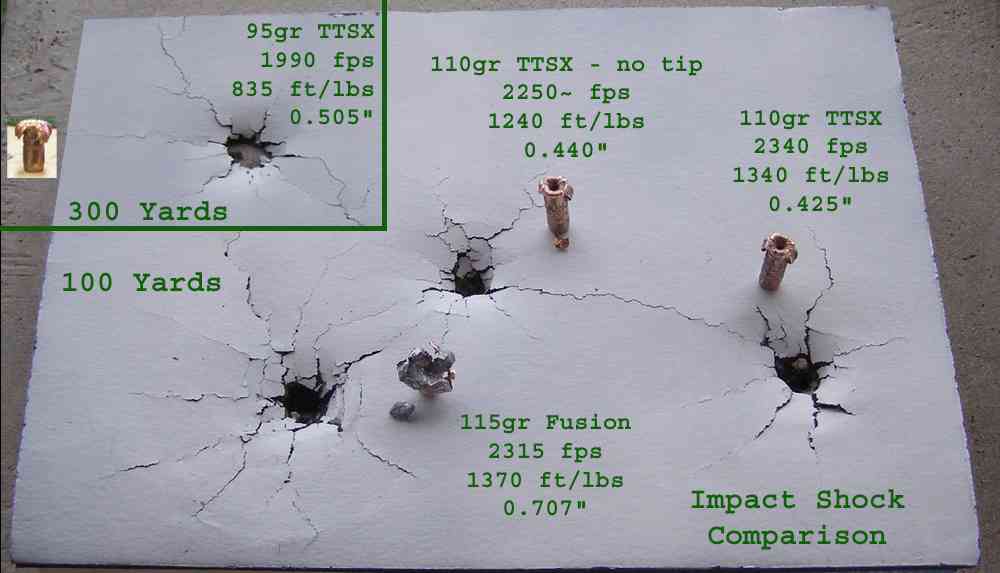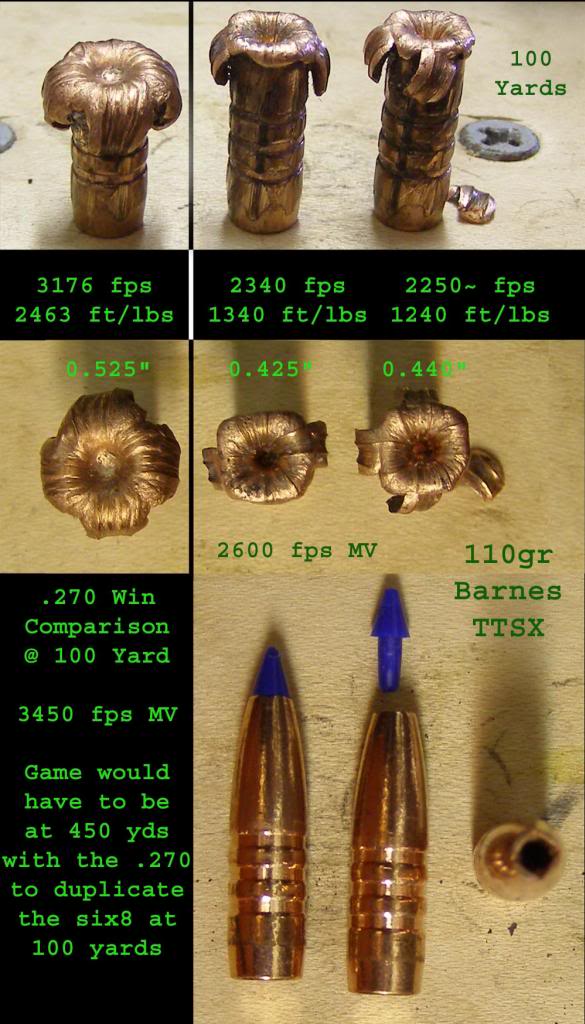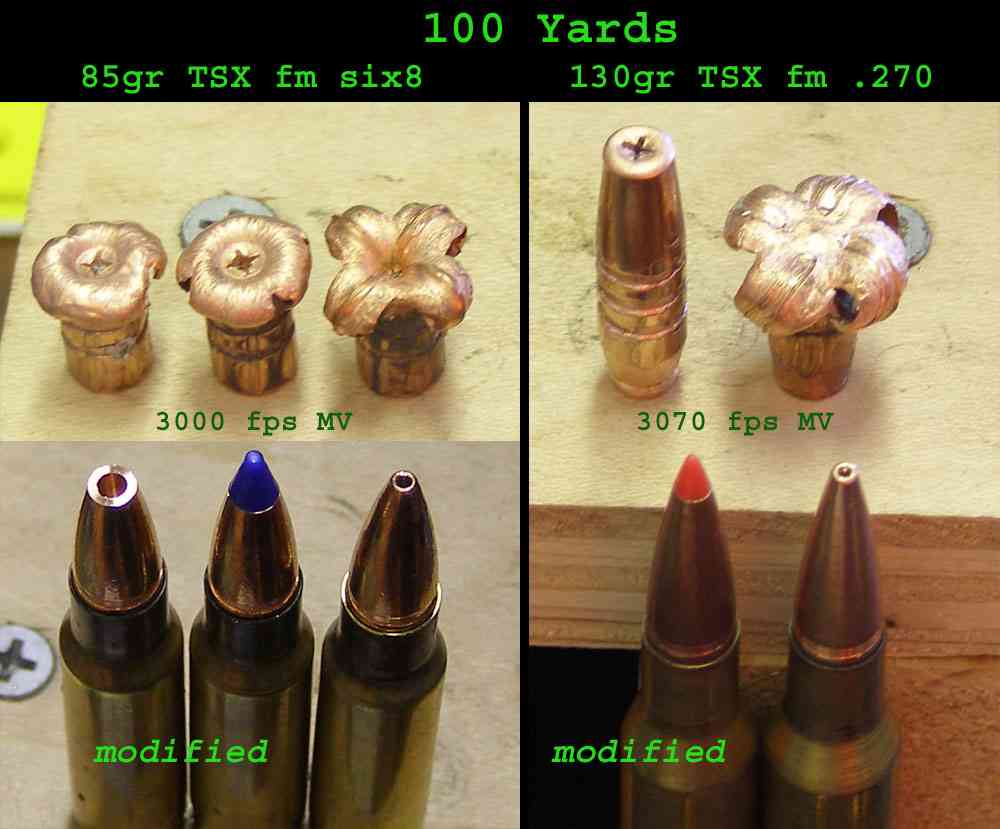There is useful information spread throughout this topic regarding six8 bullet terminal performance. As it has grown in length, these links have been added to take you directly to pages where new bullets and additional testing were added.
100 Yard Terminal Testing; Barnes 85gr TSX & 95gr TTSX, Sierra 90gr HP, Hornady 110gr V-Max & HPBT and 120gr SST
starts with this post below the links.
100 Yard Terminal Testing; Nosler 100gr and 110gr Accubond
6.8 SPC Bullet Performance
200 Yard Terminal Testing; Barnes 85gr TSX & 95gr TTSX, Nosler 100gr & 110gr AccuBond, 120gr Hornady SST
6.8 SPC Bullet Performance
300 Yard Terminal Testing; Barnes 95gr TTSX, Nosler 100gr & 110gr AccuBond, 120gr Hornady SST
6.8 SPC Bullet Performance
100 & 200 Yard Terminal Testing; Barnes 85gr TSX, Nosler 85gr E-Tip, Sierra 110gr Pro-Hunter, Berger 130gr VLD,
http://68forums.com/forums/showthre.../showthread.php?33178-6-8-SPC-Bullet-Performance&p=416527&viewfull=1#post416527
Round 2 -> 100 & 200 Yard Terminal Testing; Hornady 110gr HP and HPBT, Nosler 115gr Match
6.8 SPC Bullet Performance
Round 2 -> 300 Yard Terminal Testing; Nosler 85gr E-Tip, Barnes 95gr TTSX, Sierra 110gr ProHunter, Nosler 110gr AccuBond, Federal 115gr Fusion MSR
6.8 SPC Bullet Performance
Comparison: 100gr & 110gr Nolser AccuBond with 115gr Federal Fusion MSR
6.8 SPC Bullet Performance
Round 2 -> 200 Yard Terminal Testing; Sierra 90gr HP, Hornady 110gr V-Max & HP, Sierra 110gr ProHunter, Federal 115gr Fusion MSR
6.8 SPC Bullet Performance
Round 2 -> 300 Yard Terminal Testing; Sierra 90gr HP, Hornady 110gr V-Max, HP & BTHP, Nosler 115gr Match
6.8 SPC Bullet Performance
Federal Fusion MSR/GD Bullet Performance Comparison - 90gr Gold Dot, 115gr and 120gr Fusion MSR
6.8 SPC Bullet Performance
Benefits of Ballistic Tips (or what happens when you remove them on monolithic bullets)
6.8 SPC Bullet Performance
100 Yard Terminal Performance Testing; 110gr Barnes TTSX
6.8 SPC Bullet Performance
100-300 Yard Terminal Performance Testing; 110gr Barnes TSX
6.8 SPC Bullet Performance
All Copper Bullet Comparison; 85gr Nosler E-Tip, 85gr Barnes TSX, 95gr Barnes TTSX, 110gr Barnes TSX
http://68forums.com/forums/showthre.../showthread.php?33178-6-8-SPC-Bullet-Performance&p=456500&viewfull=1#post456500
What Defines Bullet Expansion? An analysis of monolithic and lead-core bullet performance.
http://68forums.com/forums/showthre.../showthread.php?33178-6-8-SPC-Bullet-Performance&p=457110&viewfull=1#post457110
Effects of Barrel Twist Rate on Bullet Expansion.
http://68forums.com/forums/showthre.../showthread.php?33178-6-8-SPC-Bullet-Performance&p=633586&viewfull=1#post633586
Round 3 - > 130gr Bullets
130gr Bullet Testing; Hornady SST, Sierra Pro-Hunter, Nosler Ballistic Tip and E-Tip http://68forums.com/forums/showthre.../showthread.php?33178-6-8-SPC-Bullet-Performance&p=471451&viewfull=1#post471451
130gr Berger VLD http://68forums.com/forums/showthre.../showthread.php?33178-6-8-SPC-Bullet-Performance&p=416533&viewfull=1#post416533
130gr Nosler Partition http://68forums.com/forums/showthre.../showthread.php?33178-6-8-SPC-Bullet-Performance&p=533428&viewfull=1#post533428
130gr Sierra GameKing http://68forums.com/forums/showthre.../showthread.php?33178-6-8-SPC-Bullet-Performance&p=562847&viewfull=1#post562847
130gr Federal Fusion, Remington Core-Lokt, and Speer Hot-Core http://68forums.com/forums/showthre.../showthread.php?33178-6-8-SPC-Bullet-Performance&p=616848&viewfull=1#post616848
130gr Speer BTSP http://68forums.com/forums/showthre.../showthread.php?33178-6-8-SPC-Bullet-Performance&p=628630&viewfull=1#post628630
130 Hornady InterLock and Woodleigh PP SN http://68forums.com/forums/showthre.../showthread.php?33178-6-8-SPC-Bullet-Performance&p=681588&viewfull=1#post681588
130 Federal Flat-Base http://68forums.com/forums/showthre.../showthread.php?33178-6-8-SPC-Bullet-Performance&p=946545&viewfull=1#post946545
130 Cutting Edge MTH http://68forums.com/forums/showthre.../showthread.php?33178-6-8-SPC-Bullet-Performance&p=959122&viewfull=1#post959122
400 Yard Terminal Performance Testing
Comparison: Nosler 90gr Bonded Core vs Federal 90gr Gold Dot
http://68forums.com/forums/showthre.../showthread.php?33178-6-8-SPC-Bullet-Performance&p=561863&viewfull=1#post561863
GS Customer Bullets for the 6.8 SPC: 80gr and 99gr HV
http://68forums.com/forums/showthre.../showthread.php?33178-6-8-SPC-Bullet-Performance&p=578650&viewfull=1#post578650
Hornady's New 100gr GMX
http://68forums.com/forums/showthre.../showthread.php?33178-6-8-SPC-Bullet-Performance&p=581055&viewfull=1#post581055
Comparison: Hornady 100gr Soft Point vs Remington 100gr Pointed Soft Point
http://68forums.com/forums/showthre.../showthread.php?33178-6-8-SPC-Bullet-Performance&p=594765&viewfull=1#post594765
Sellier & Bellot 110 FMJ
http://68forums.com/forums/showthre.../showthread.php?33178-6-8-SPC-Bullet-Performance&p=605488&viewfull=1#post605488
Remington 115gr Ultra-Bond
http://68forums.com/forums/showthre.../showthread.php?33178-6-8-SPC-Bullet-Performance&p=616848&viewfull=1#post616848
Lehigh Defense 100gr Controlled Chaos (CC)
http://68forums.com/forums/showthre.../showthread.php?33178-6-8-SPC-Bullet-Performance&p=642566&viewfull=1#post642566
Comparison: 110gr Hornady V-MAX and Sellier & Ballot Plastic Tip Special (PTS)
http://68forums.com/forums/showthre.../showthread.php?33178-6-8-SPC-Bullet-Performance&p=681671&viewfull=1#post681671
Cutting Edge 120gr & 130gr Match, Tactical, Hunting (MTH)
http://68forums.com/forums/showthre.../showthread.php?33178-6-8-SPC-Bullet-Performance&p=959122&viewfull=1#post959122
Speer 90gr TNT HP
http://68forums.com/forums/showthread.php?33178-6-8-SPC-Bullet-Performance&p=976985&viewfull=1#post976985
Cavity Back Bullets 105gr & 120gr MKZ
http://68forums.com/forums/showthre.../showthread.php?33178-6-8-SPC-Bullet-Performance&p=983682&viewfull=1#post983682
Nosler 110gr Flat-Base Soft Point (FBSP)
http://68forums.com/forums/showthre...howthread.php?33178-6-8-SPC-Bullet-Performance&p=1021418&viewfull=1#post1021418
Cavity Back Bullets 95 CB Tech
http://68forums.com/forums/showthre...howthread.php?33178-6-8-SPC-Bullet-Performance&p=1072809&viewfull=1#post1072809
Winchester 115gr XP
https://www.68forums.com/threads/6-8-spc-bullet-performance.33178/post-1455900
____
Original Post
____
I had the opportunity to take six 6.8 SPC bullet combinations to the range and test terminal performance. My goal was to verify the bullet I would be using for deer and hogs. I tested performance using a bullet "trap" that I have refined and used for a couple of years. The trap consists of a gallon jug of water (typically an empty milk jug) in front of a box of phone books and magazines. The water jug provides the hydraulic medium to effect bullet expansion/mushrooming. The box catches the bullets and provides relative penetration performance. I've used this bullet trap with .223 Rem to .300 Win Mag and have seen similar terminal performance results on elk I have harvested with a .270 Win. With that said, I realize this method of testing is not as good a medium as ballistic gelatin but that's a whole other story and not very convenient to use. More details on the bullet trap can be found in this on-line article. Note, I now use a single phone book in front of multiple magazines like G&A, Shooting Times, etc.
http://www.huntingnut.com/index.php?name=News&file=article&sid=84
These are the bullets and their respective muzzle velocities shot from and 18-inch PSA SS SPR barrel. There was a 15+ mph headwind and the temperature was 48F.
85gr Barnes TSX - 2815 fps (31.0gr AA2200)
90gr Sierra HP - 2775 fps (30.5gr AA2200)
95gr Barnes TTSX - 2805 fps (29.6gr AA2200)
110gr Hornady V-Max - 2615 fps (factory)
110gr Hornady HPBT - 2640 fps (factory)
120gr Hornady SST - 2525 fps (27.5gr AA2200)
Caution - these loads worked in my rifle but this is no guarantee that they will work safely in yours.
Here is a link to a picture of the 6.8mm (0.277") bullets used with some .270 Win bullets I typically load on the right side for reference.
![Image]()
100 Yard Terminal Testing; Barnes 85gr TSX & 95gr TTSX, Sierra 90gr HP, Hornady 110gr V-Max & HPBT and 120gr SST
starts with this post below the links.
100 Yard Terminal Testing; Nosler 100gr and 110gr Accubond
6.8 SPC Bullet Performance
200 Yard Terminal Testing; Barnes 85gr TSX & 95gr TTSX, Nosler 100gr & 110gr AccuBond, 120gr Hornady SST
6.8 SPC Bullet Performance
300 Yard Terminal Testing; Barnes 95gr TTSX, Nosler 100gr & 110gr AccuBond, 120gr Hornady SST
6.8 SPC Bullet Performance
100 & 200 Yard Terminal Testing; Barnes 85gr TSX, Nosler 85gr E-Tip, Sierra 110gr Pro-Hunter, Berger 130gr VLD,
http://68forums.com/forums/showthre.../showthread.php?33178-6-8-SPC-Bullet-Performance&p=416527&viewfull=1#post416527
Round 2 -> 100 & 200 Yard Terminal Testing; Hornady 110gr HP and HPBT, Nosler 115gr Match
6.8 SPC Bullet Performance
Round 2 -> 300 Yard Terminal Testing; Nosler 85gr E-Tip, Barnes 95gr TTSX, Sierra 110gr ProHunter, Nosler 110gr AccuBond, Federal 115gr Fusion MSR
6.8 SPC Bullet Performance
Comparison: 100gr & 110gr Nolser AccuBond with 115gr Federal Fusion MSR
6.8 SPC Bullet Performance
Round 2 -> 200 Yard Terminal Testing; Sierra 90gr HP, Hornady 110gr V-Max & HP, Sierra 110gr ProHunter, Federal 115gr Fusion MSR
6.8 SPC Bullet Performance
Round 2 -> 300 Yard Terminal Testing; Sierra 90gr HP, Hornady 110gr V-Max, HP & BTHP, Nosler 115gr Match
6.8 SPC Bullet Performance
Federal Fusion MSR/GD Bullet Performance Comparison - 90gr Gold Dot, 115gr and 120gr Fusion MSR
6.8 SPC Bullet Performance
Benefits of Ballistic Tips (or what happens when you remove them on monolithic bullets)
6.8 SPC Bullet Performance
100 Yard Terminal Performance Testing; 110gr Barnes TTSX
6.8 SPC Bullet Performance
100-300 Yard Terminal Performance Testing; 110gr Barnes TSX
6.8 SPC Bullet Performance
All Copper Bullet Comparison; 85gr Nosler E-Tip, 85gr Barnes TSX, 95gr Barnes TTSX, 110gr Barnes TSX
http://68forums.com/forums/showthre.../showthread.php?33178-6-8-SPC-Bullet-Performance&p=456500&viewfull=1#post456500
What Defines Bullet Expansion? An analysis of monolithic and lead-core bullet performance.
http://68forums.com/forums/showthre.../showthread.php?33178-6-8-SPC-Bullet-Performance&p=457110&viewfull=1#post457110
Effects of Barrel Twist Rate on Bullet Expansion.
http://68forums.com/forums/showthre.../showthread.php?33178-6-8-SPC-Bullet-Performance&p=633586&viewfull=1#post633586
Round 3 - > 130gr Bullets
130gr Bullet Testing; Hornady SST, Sierra Pro-Hunter, Nosler Ballistic Tip and E-Tip http://68forums.com/forums/showthre.../showthread.php?33178-6-8-SPC-Bullet-Performance&p=471451&viewfull=1#post471451
130gr Berger VLD http://68forums.com/forums/showthre.../showthread.php?33178-6-8-SPC-Bullet-Performance&p=416533&viewfull=1#post416533
130gr Nosler Partition http://68forums.com/forums/showthre.../showthread.php?33178-6-8-SPC-Bullet-Performance&p=533428&viewfull=1#post533428
130gr Sierra GameKing http://68forums.com/forums/showthre.../showthread.php?33178-6-8-SPC-Bullet-Performance&p=562847&viewfull=1#post562847
130gr Federal Fusion, Remington Core-Lokt, and Speer Hot-Core http://68forums.com/forums/showthre.../showthread.php?33178-6-8-SPC-Bullet-Performance&p=616848&viewfull=1#post616848
130gr Speer BTSP http://68forums.com/forums/showthre.../showthread.php?33178-6-8-SPC-Bullet-Performance&p=628630&viewfull=1#post628630
130 Hornady InterLock and Woodleigh PP SN http://68forums.com/forums/showthre.../showthread.php?33178-6-8-SPC-Bullet-Performance&p=681588&viewfull=1#post681588
130 Federal Flat-Base http://68forums.com/forums/showthre.../showthread.php?33178-6-8-SPC-Bullet-Performance&p=946545&viewfull=1#post946545
130 Cutting Edge MTH http://68forums.com/forums/showthre.../showthread.php?33178-6-8-SPC-Bullet-Performance&p=959122&viewfull=1#post959122
400 Yard Terminal Performance Testing
- The Challenges of Longer Range Shooting
- Varmint/Target Bullets: 110gr Hornady HPBT & V-Max, 115gr Nosler Match CC
- Hunting Bullets: 90gr Gold Dot, 95gr Barnes TTSX, 110gr Barnes TSX, 110gr Nosler Accubond, 120gr Fusion MSR, 120gr Hornady SST
Comparison: Nosler 90gr Bonded Core vs Federal 90gr Gold Dot
http://68forums.com/forums/showthre.../showthread.php?33178-6-8-SPC-Bullet-Performance&p=561863&viewfull=1#post561863
GS Customer Bullets for the 6.8 SPC: 80gr and 99gr HV
http://68forums.com/forums/showthre.../showthread.php?33178-6-8-SPC-Bullet-Performance&p=578650&viewfull=1#post578650
Hornady's New 100gr GMX
http://68forums.com/forums/showthre.../showthread.php?33178-6-8-SPC-Bullet-Performance&p=581055&viewfull=1#post581055
Comparison: Hornady 100gr Soft Point vs Remington 100gr Pointed Soft Point
http://68forums.com/forums/showthre.../showthread.php?33178-6-8-SPC-Bullet-Performance&p=594765&viewfull=1#post594765
Sellier & Bellot 110 FMJ
http://68forums.com/forums/showthre.../showthread.php?33178-6-8-SPC-Bullet-Performance&p=605488&viewfull=1#post605488
Remington 115gr Ultra-Bond
http://68forums.com/forums/showthre.../showthread.php?33178-6-8-SPC-Bullet-Performance&p=616848&viewfull=1#post616848
Lehigh Defense 100gr Controlled Chaos (CC)
http://68forums.com/forums/showthre.../showthread.php?33178-6-8-SPC-Bullet-Performance&p=642566&viewfull=1#post642566
Comparison: 110gr Hornady V-MAX and Sellier & Ballot Plastic Tip Special (PTS)
http://68forums.com/forums/showthre.../showthread.php?33178-6-8-SPC-Bullet-Performance&p=681671&viewfull=1#post681671
Cutting Edge 120gr & 130gr Match, Tactical, Hunting (MTH)
http://68forums.com/forums/showthre.../showthread.php?33178-6-8-SPC-Bullet-Performance&p=959122&viewfull=1#post959122
Speer 90gr TNT HP
http://68forums.com/forums/showthread.php?33178-6-8-SPC-Bullet-Performance&p=976985&viewfull=1#post976985
Cavity Back Bullets 105gr & 120gr MKZ
http://68forums.com/forums/showthre.../showthread.php?33178-6-8-SPC-Bullet-Performance&p=983682&viewfull=1#post983682
Nosler 110gr Flat-Base Soft Point (FBSP)
http://68forums.com/forums/showthre...howthread.php?33178-6-8-SPC-Bullet-Performance&p=1021418&viewfull=1#post1021418
Cavity Back Bullets 95 CB Tech
http://68forums.com/forums/showthre...howthread.php?33178-6-8-SPC-Bullet-Performance&p=1072809&viewfull=1#post1072809
Winchester 115gr XP
https://www.68forums.com/threads/6-8-spc-bullet-performance.33178/post-1455900
____
Original Post
____
I had the opportunity to take six 6.8 SPC bullet combinations to the range and test terminal performance. My goal was to verify the bullet I would be using for deer and hogs. I tested performance using a bullet "trap" that I have refined and used for a couple of years. The trap consists of a gallon jug of water (typically an empty milk jug) in front of a box of phone books and magazines. The water jug provides the hydraulic medium to effect bullet expansion/mushrooming. The box catches the bullets and provides relative penetration performance. I've used this bullet trap with .223 Rem to .300 Win Mag and have seen similar terminal performance results on elk I have harvested with a .270 Win. With that said, I realize this method of testing is not as good a medium as ballistic gelatin but that's a whole other story and not very convenient to use. More details on the bullet trap can be found in this on-line article. Note, I now use a single phone book in front of multiple magazines like G&A, Shooting Times, etc.
http://www.huntingnut.com/index.php?name=News&file=article&sid=84
These are the bullets and their respective muzzle velocities shot from and 18-inch PSA SS SPR barrel. There was a 15+ mph headwind and the temperature was 48F.
85gr Barnes TSX - 2815 fps (31.0gr AA2200)
90gr Sierra HP - 2775 fps (30.5gr AA2200)
95gr Barnes TTSX - 2805 fps (29.6gr AA2200)
110gr Hornady V-Max - 2615 fps (factory)
110gr Hornady HPBT - 2640 fps (factory)
120gr Hornady SST - 2525 fps (27.5gr AA2200)
Caution - these loads worked in my rifle but this is no guarantee that they will work safely in yours.
Here is a link to a picture of the 6.8mm (0.277") bullets used with some .270 Win bullets I typically load on the right side for reference.













